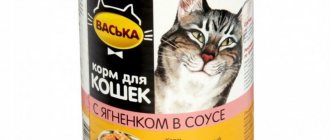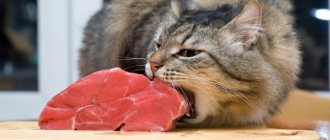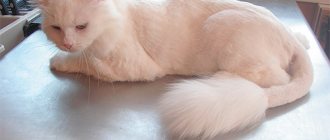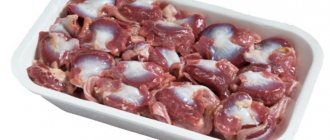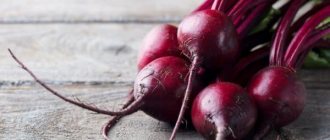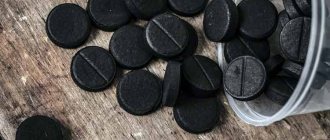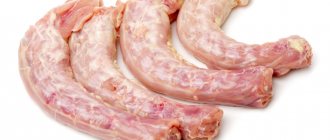Fruits and vegetables are beneficial not only for the human body; veterinary doctors also recommend giving them to cats. Plant products contain important elements for the normal growth and development of animals. However, not every vegetable and fruit is beneficial for the pet’s body, so the owner should first figure out what exactly is acceptable to include in the pet’s diet.
What vegetables can you give your cat?
In plant foods, fiber is the main value for cats.
It is not digested and does not contain nutrients, but it helps remove swallowed fur from the stomach, improves intestinal motility, and stabilizes stool. Vegetables bring moisture into the body; cats are reluctant to drink pure water and prefer to receive it with food. Cats absorb micronutrients of plant origin. In healthy animals, vegetables make up 5–10% of the diet. For overweight cats, the amount is increased to 20%. Plant fiber gives you a feeling of fullness, but does not increase calorie content. For cats, choose only fresh food without rot, damage, or stains. Frozen ones are also good; they retain the beneficial ingredients.
Vegetables are properly processed:
- First, wash under cold water, peel, and remove the seeds.
- When cooking, do not add salt, spices or seasonings. They disrupt water balance and metabolism. It’s healthier to cook fresh ones in meat broth instead of water, while frozen ones are steamed.
- Vegetables are chopped: raw ones are grated, greens are chopped with a knife, boiled ones are finely chopped or passed through a strainer or blender.
- Cooked vegetables are given as an independent “dish”, diluted with broth or mixed with meat, the proportions are adhered to: 3/4 protein food, 1/4 vegetable food.
- Add 3-5 drops of olive or sunflower oil to the prepared food; without it, fat-soluble vitamins will not be absorbed.
It is difficult to imagine a cat who eats only vegetables, but if this happens, he gets sick and dies. Plants do not contain animal proteins, amino acids, or fatty acids that cats need. Cats do not like vegetables with a strong, bitter taste. It is better to choose neutral types that absorb and do not clog the smell of meat.
The table indicates the crops that can be added to the diet:
| Kinds | Benefits for the cat |
| Carrot | Includes beta-carotene, it synthesizes vitamin A and is not destroyed by heat treatment |
| Zucchini | Contains antioxidants, iron. Soft fiber does not irritate the intestines |
| Pumpkin | Includes the rare component carnitine, it accelerates fat burning, helps build muscle mass, and renews the gastrointestinal mucosa |
| Beet | Dietary fiber supports the excretory functions of the intestines. The vitamin and mineral composition does not change after cooking |
| Broccoli | Increased amount of vitamins B, C, K, carotene |
| Cucumber | Improves the absorption of meat proteins |
| Green bean | It has a rich composition of minerals, 100 g contains only 30 kcal |
| Cauliflower | Includes few hard fibers, so it is easily digested and does not irritate the stomach. |
| Leaf salad | The amount of calcium is not inferior to dairy products, has a beneficial effect on the liver |
| Parsley, celery, dill | Enrich food with microelements, accelerate urine excretion, warns the ICD |
| Spinach | Useful composition of vitamins and minerals, preserved after heat treatment |
If the animal refuses vegetables, you will have to add bran to the “dishes” or grow grass from sprouted grains of barley, oats, and wheat.
Olives
Many owners have noticed that their pets beg for olives, barely smelling the smell emanating from an open jar. Having received treats, cats chase them around the floor, play with them, lick them, and sometimes eat them. In Greece, local cats can even eat the bark of olive trees, sharpen their claws on them, or simply rub against the trunk. It's all because of oleuropein, a biologically active substance that has a stimulating effect on furry purrs. It is because of this that olives have a sour taste that cats are so attracted to.
Olives have beneficial properties:
- reduce cholesterol levels;
- improve metabolism;
- rich in various vitamins and microelements.
However, in canned form, the beneficial effect of the fruit is halved. Manufacturers add too much salt and preservatives to jars to ensure long-term storage. Accordingly, you shouldn’t give your cat a lot of olives.
What vegetables should you not feed your cat?
When feeding, the following restrictions are observed:
- Plant products are not mixed with fermented milk; beneficial substances are less easily absorbed.
- Do not give large pieces: the animal risks choking.
- It is not added to industrial feed; it already contains fiber.
- Early vegetables do not have time to accumulate vitamins; they contain more nitrates.
- Pickled foods include salt, spices, and vinegar, which lead to metabolic failure.
- Fried ones contain excess fat and harm the liver and pancreas.
- Add a significant amount of salt to the salted ones. It is deposited in the bladder and kidneys, leading to the development of urolithiasis.
- Harmful ingredients are added to canned vegetable salads: pepper, garlic, vinegar, salt.
- When purchasing frozen mixtures, carefully study the ingredients so that they do not contain crops that are toxic to pets.
The following vegetables are prohibited for cats:
| Kinds | Harm to the cat |
| White cabbage | Causes fermentation in the gastrointestinal tract, bloating, increased gas formation |
| Onion | Contains disulfides, they destroy red blood cells, which causes anemia. The lethal proportion is 0.5% of body weight |
| Garlic | Also includes disulfides, but in smaller quantities |
| Avocado | The skin and pit contain the toxic element persin, which causes poisoning with vomiting and diarrhea. |
| Raw potatoes | Includes the toxic component solanine, it changes the composition of the blood, depresses the nervous system, and impairs kidney function. Its concentration increases in green, sprouted tubers |
| Boiled potatoes | After heat treatment, solanine levels decrease, but excess starch disrupts metabolism |
| Raw tomatoes, eggplants | Also includes solanine, its amount is higher in unripe tomatoes |
| Rhubarb, sorrel | Salts of oxalic acid provoke urolithiasis |
| Legumes: peas, beans, soybeans | They are not digestible and cause gas formation, because their main components are plant proteins and carbohydrates |
When fed these vegetables, cats begin to develop health problems: from indigestion to severe poisoning.
Basic feeding rules
How to feed a cat natural food at home: nutritional features
Caring for a pet requires compliance with certain rules:
- food for cats should be uncombined; mixing ready-made industrial products with self-prepared food leads to hypervitaminosis and vitamin deficiency at the same time;
- frequency of intake and type of diet directly depend on the individual characteristics of the pet;
- when choosing ready-made dry biscuits or wet canned food, it is better to give preference to one manufacturer, since alternating different brands will cause an imbalance of nutrients;
- The freshness of the food is important; four-legged animals should not be given food that has passed its expiration date;
- the cat should have its own corner for eating;
- Equally important is compliance with the drinking regime; the animal must have free access to water;
- cold foods cause disruption of the gastrointestinal tract, hot foods cause injuries to the mucous membranes;
- If the pet cannot eat large and hard pieces, then they need to be crushed.
Important! The transition to a new type of diet is carried out gradually. A sudden change can cause starvation and further health problems.
Why vegetables can be dangerous
In addition to toxins, vegetables contain traces of chemicals used in agriculture:
- Pesticides are used to protect crops from diseases, insects, and kill weeds. They cover the skin and penetrate plant tissue. When accumulated in the body, they provoke skin rashes, nausea, diarrhea, and stomach pain.
- Nitrates are formed in vegetables naturally during the breakdown of organic matter with nitrogen and come from the soil along with fertilizers. They do not cause harm, but in the body they are converted into toxic nitrites, which cause spasms and slow down blood flow. In case of severe poisoning, the structure of hemoglobin changes and it stops carrying oxygen to the tissues. In severe cases, the animal develops hypoxia, the mucous membranes of the intestines and stomach become inflamed, and protein and carbohydrate metabolism are disrupted.
An allergy to plant components cannot be ruled out. An unfamiliar vegetable species is first given only to try and the pet’s reaction is observed.
Diet features
- Little: you should be surprised if your four-legged pet eats vegetables. There is nothing surprising in this manner. These edibles are included in the basic ready-made food for cats, so often the necessary enzymes are already present in the animal’s body. But if there is a deficiency, the animal may gravitate towards food of plant origin. However, we should look at the question regarding what value vegetables have, no more and no less, for the animal body.
- Representatives of the cat family, even domestic ones, are predators, this is no secret. In order for four-legged pets to get energy, they need a proper diet. The basis is fish and meat, but plant components must also be present. If you replace meat with vegetables, the animal will be at risk. And if you simply give vegetables as a supplement, you will be able to stabilize the balance of BJU.
- Feline digestion is a multi-faceted issue. In order for a cat to always be full of energy, he needs fiber. It can be obtained in full by supplying vegetable crops permitted for consumption. In addition, vegetables are rich in mineral compounds, vitamins and other important components. Dietary fiber ensures high-quality digestion of meat foods, so they are necessary.
- The cat's intestinal motility improves, balance disappears, and pathogenic microflora is destroyed. Many owners of four-legged pets claim that after introducing vegetable crops into the basic diet, animals eat grass on the street cheaper. The cat family is fed pickles in boiled or raw form. However, in all respects you need to know when to stop.
How to keep vegetables safe
The concentration of harmful substances is reduced in the following ways:
- The animal is fed seasonal vegetables : less fertilizer is used during cultivation. In winter it is better to use frozen ones.
- Food is kept in the refrigerator : in a warm environment, nitrates quickly turn into nitrites.
- Fruits and greens are thoroughly rinsed : water washes away dirt, harmful microorganisms, and chemicals from the surface.
- The peel, stalks, and tails are cut off , the top leaves are removed from the salad, the stems are removed from parsley and dill: in these parts the level of nitrates is higher. In carrots they are concentrated in the core.
- Greens and peeled fruits are kept in water for half an hour , toxic substances pass into the liquid.
- When cooking, the amount of nitrates is reduced by 50–80% , the poisonous solanine in potatoes, tomatoes, and eggplants is destroyed.
- Heat treatment will not help neutralize the toxic effects of disulfides in onions, garlic, and persin in avocado peels. These vegetables are excluded from the diet.
Choosing a diet for a two-month-old kitten
If the diet is chosen correctly, then soon the clumsy baby will turn into a playful, strong and powerful cat or a beautiful healthy cat. The main signal that the food is not suitable for the kitten is an intestinal disorder and the animal’s categorical refusal of the offered treat.
There are three options for suitable nutrition for young cats, and the choice should be made on one of them:
Probably, the kitten himself will make the choice for the owner. But sometimes it’s worth calculating your financial capabilities and choosing the best option. The breed of the cat, its health and preferences also play a role.
Raw or cooked
The opinions of felinologists and veterinarians differ, but there are no strict prohibitions regarding either fresh or boiled vegetables. Cats are reluctant to eat them, so owners often follow the pet’s taste and give them in the form that he likes. Be sure to cook food for animals with diseases of the gastrointestinal tract.
The need for treatment for healthy cats depends on the stiffness of the fibers:
- beets , cabbage , pumpkin are boiled to soften coarse fiber and reduce the concentration of nitrates;
- tomatoes , potatoes , eggplants are processed to remove solanine;
- greens and cucumbers are given raw;
- zucchini , green beans , and carrots are fed fresh and boiled.
Plant food is a secondary but necessary component of a cat’s diet. They are taught to eat them from childhood, they are given vegetables that the pet eats, except toxic ones, and they are prepared correctly.
Juniper
When eaten fresh, juniper is not of particular interest to cats. However, in the form of essential oil, this plant has an effect similar to catnip: the animal appears in a playful mood. Most often it is used when they want to accustom a cat to a new place of residence, a bed, a scratching post or a toilet. The effect can be enhanced if you mix juniper and catnip, then the pet will not move away from the treated area.
This plant also has healing properties:
- good diuretic effect;
- antiallergic effect;
- treatment of joint inflammation (arthritis).
In addition, cats enjoy chewing juniper branches: this way they sharpen and clean their teeth.
What to give to spayed and neutered animals
Neutered cats need to pay extra attention to their food. The fact is that they are especially prone to diseases of the genitourinary system, intestinal disorders and obesity
Giving fish is completely prohibited. It contains a lot of minerals and proteins that will have a detrimental effect on health.
Only specially selected food can provide all the necessary vitamins to a sterilized cat.
It is recommended that such animals be completely switched to special feed. This will provide their bodies with the necessary nutrients that will stabilize hormonal levels and prevent obesity.
We recommend viewing
Can cats eat beef jerky? Can cats eat boiled squid? Can cats eat jelly?
Luckily, most cats that taste hot peppers will likely spit them out before they reach their stomach, but keep an eye on your cat anyway.
Can cats be allergic to bell peppers? It's unlikely, but cats can be allergic or sensitive to any food, so it could happen. Signs of a food allergy include:
- Vomit
- diarrhea
- Itching
- Hair loss and excessive scratching
- gurgling sounds in the stomach
- Farting
These symptoms may take a few days to appear, so if your cat is new to bell peppers, keep an eye on her.
Can I give it to a cat?
In the absence of pathological processes, lactation period and other negative factors, cucumber can and is even recommended to be given to an animal. The product, rich in vitamin complex and beneficial substances, has a beneficial effect on the body and will also prevent the cat from feeling thirsty. The only contraindication is taking lightly salted or canned cucumbers for your pet. They contain much less minerals, there is an excessive amount of salt and sugar, which will not have the best effect on the condition of the body.
